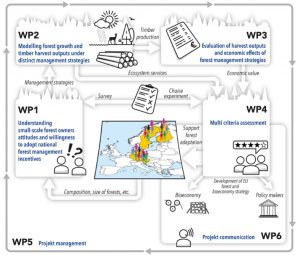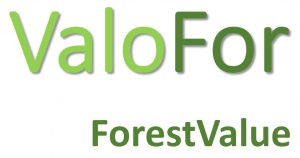ValoFor project is structured into four scientific work packages and two administrative work packages:
WP1: Understanding small forest owners attitudes and willingness to adopt national forest management incentives
In WP1 we aim at collecting data on the size and structure of small forest owners as well as – via surveys – on their perception towards the bioeconomy, forest management, climate change adaptation and forest conservation, for example. Moreover, WP1 synthesizes the different national incentive schemes. Based on the observed composition and behaviour, the three management strategies (business as usual, income-oriented, resilience-oriented) will be specified on the national level as input to WP2.
WP2: Modelling forest growth and timber harvest outputs under the distinct management strategies
WP2 will model timber supply and the provision of ecosystem services (carbon storage, biodiversity, etc.) of small forest owners under these three strategies across the five partner countries in relation to the countries overall wood production and the domestic raw wood supply. The latter are input to WP3.
WP3: Evaluation of harvest outputs and economic effects of forest management strategies
In WP3 the simulation results will be transformed into economic outputs on the scale of the forest property with respect to existing and potential incentive schemes. WP3 will also use economic modelling of various forest owner composition (from WP1) for a theoretical analysis of forest owner’s incomes in relation to forest types, forest size, and management strategies. Another output of the modelling in WP2 are the provision of ecosystem services and the resilience of forests in climate change. These outputs are the basis for an quantitative analysis of trade-offs between timber production, different ecosystem services and forest resilience towards climate change which will be made in WP4.
WP4: Multi criteria assessment
WP4 will also provide in-depth analysis of the forest owners perception towards the different forest functions and compare these perceptions with the simulated trade-offs in order to identify mismatches between forest management intensions and truly achievable targets. This comparison will result into a trade-off based multiscoring system for strategy development for forest owners, policy makers and stakeholders.
WP5: Project management
The implementation of the WPs 1-4 will be overseen and coordinated by WP5. In particular the common survey of WP1 and WP4, the transfer of modeling in- and outputs between WPs, and the stakeholder involvement requires careful coordination and networking. Moreover, controlling and quality assurance is needed to ensure high research standards.
WP6: Project communications, networking and knowledge transfer
All work packages will contribute to WP6 to intensively communicate and transfer knowledge and project results to target audiences using traditional forest media (national forest journals, print materials, www.forestknowledge.net, etc.) but in particular also social media and online activities (webpage, e-Newsletters, FB, Twitter). Also intensive networking with external actors, thematically related projects and dissemination activities to researchers and stakeholders from wood and paper industry, academia and policy makers will be organized, among them a final conference.


